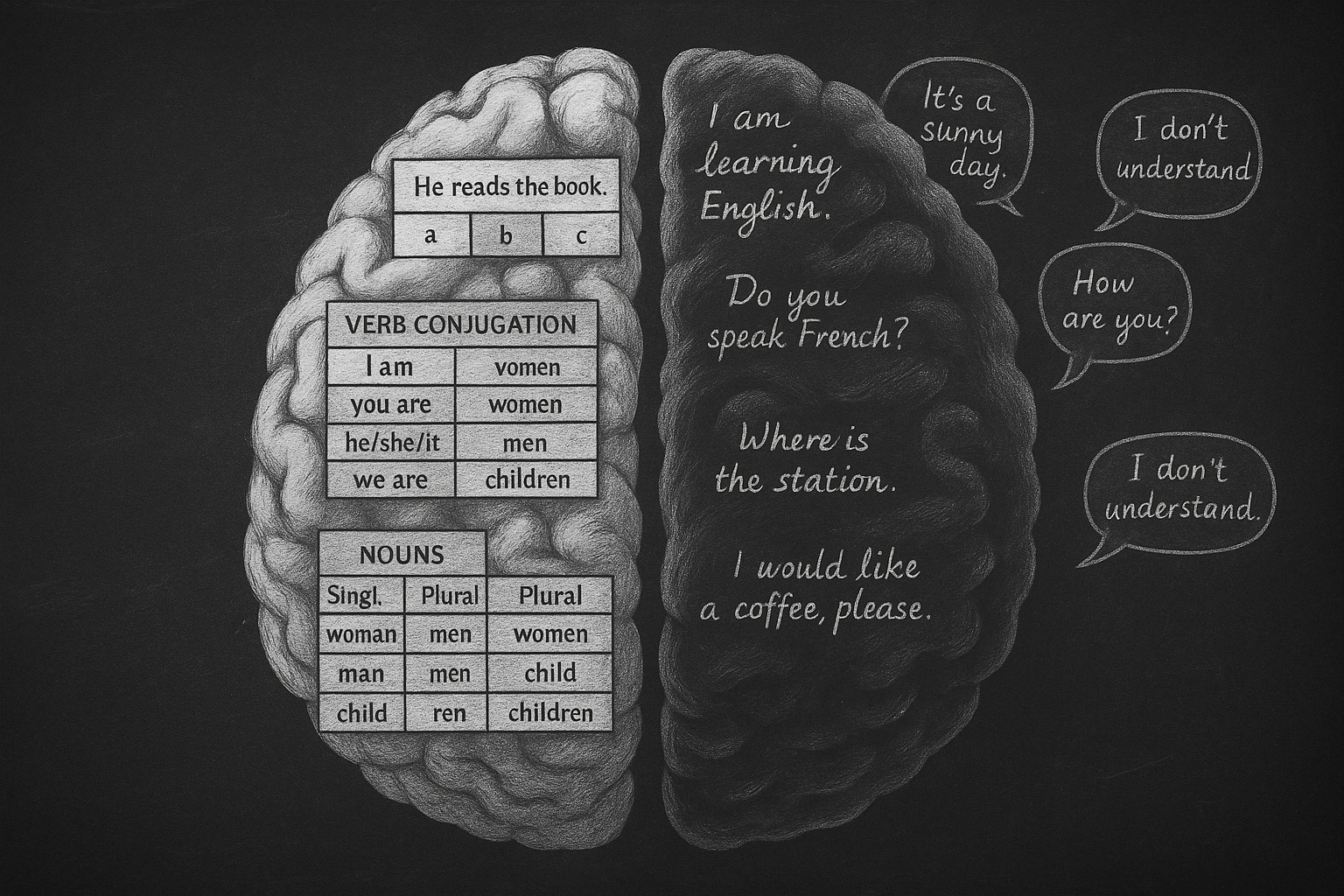Choosing the right language learning app can be overwhelming. There are dozens of platforms promising fluency, but when it comes to grammar, the differences really matter. One language learning app makes you memorize rules, other sneaks grammar into sentences, and others use AI to decide what you should study next.
Two names stand out in 2025: Taalhammer and Babbel. Both have loyal users, both teach multiple languages, and both claim to help you master grammar. But which one actually does it better? In this article, we’ll break down their methods, compare them side by side, and see which app deserves to be called the best app to learn grammar in 2025.
- Why Grammar Matters in Language Learning Apps
- Babbel’s Grammar Lessons – Rules and Structure
- Taalhammer’s Grammar Approach – Context and AI Adaptivity
- Taalhammer vs Babbel Grammar – Side-by-Side Comparison
- Best Language Learning App to Learn Grammar in 2025: Taalhammer vs Babbel
- Tips for Learning Grammar Effectively with a Language Learning App
- FAQ: Taalhammer vs Babbel Grammar Comparison
- Does Taalhammer teach grammar rules?
- What is the main difference between Taalhammer and Babbel’s grammar approach?
- Which language learning app is better for grammar practice: Taalhammer or Babbel?
- Is Babbel good for beginners who struggle with grammar?
- Is Taalhammer only for advanced learners?
- Which language learning app uses spaced repetition better, Taalhammer or Babbel?
- Can I personalize grammar learning in Taalhammer?
Why Grammar Matters in Language Learning Apps
Some learners hope they can skip grammar altogether, relying only on vocabulary lists or speaking practice, because they may think that learning grammar makes no sense. But the truth is simple: without grammar, vocabulary stays disconnected. You might know the words, but you won’t know how to put them together in a way that sounds natural.
Most learners struggle with grammar because:
- Traditional explanations feel abstract and hard to remember.
- Drills don’t always transfer into real conversation.
- Apps often treat grammar as an afterthought, focusing more on vocabulary or gamification.
That’s why grammar has become a key differentiator between apps. Some platforms, like Babbel, take a structured approach with explanations. Others, like Taalhammer, use contextual sentences and AI-driven repetition to make grammar stick naturally.
In the sections ahead, we’ll look closely at how Babbel and Taalhammer handle grammar – their methods, their strengths, and their weaknesses – before putting them head to head.
Babbel’s Grammar Lessons – Rules and Structure
How Babbel Teaches Grammar Step by Step
Babbel is built on a traditional curriculum model. Each course follows a CEFR-aligned path, starting with simple phrases and gradually moving to more complex forms. Grammar appears in nearly every lesson, often introduced with a short explanation in the learner’s native language. For example, when learning Spanish verb conjugations, you’ll see a rule box explaining endings before practicing with controlled exercises.
This approach is clear and accessible, especially for beginners who want to understand why a form is correct. However, the lessons are fixed in sequence, so you can’t adjust the order or skip ahead if you already know the basics.
Babbel Grammar Explanations vs. Practice
Babbel emphasizes noticing grammar rules. You’ll read an explanation, then practice with short fill-in-the-blank, matching, or translation tasks. Some dialogues reinforce the grammar in context, but many exercises are recognition-based rather than production-focused.
For some learners, this is helpful: rules are laid out cleanly, and you don’t have to guess. For others, the approach can feel like grammar class revisited – more theory-driven than communication-oriented.
Strengths and Limitations of Babbel’s Grammar Approach
Babbel is at its best when offering clarity and structure. Lessons are short and accessible, and rules are explained in a straightforward way. However, its fixed path and recognition-based practice limit how far grammar knowledge can go.
| Strengths | Limitations |
|---|---|
| Clear, simple rule explanations | Fixed curriculum |
| Bite-sized lessons (10-15 minutes) | Grammar recall is passive |
| Orderly, structured progression | Spaced repetition is basic |
Taalhammer’s Grammar Approach – Context and AI Adaptivity
Grammar Through Sentences, Not Rules
Taalhammer flips the script: instead of teaching rules first, it teaches grammar through sentences. Learners see grammar in action – real sentences, short dialogues, and thematic collections. Explanations exist, but they’re minimal by design. The focus is on using grammar, not memorizing charts.
For example, instead of showing you “-ed endings form the past tense,” Taalhammer introduces sentences like “I worked late yesterday”. Over time, patterns emerge naturally, just as they do in real-life language acquisition.
AI Spaced Repetition and Grammar Retention
What makes Taalhammer stand out is its AI-driven recall system. The language learning app tracks how well you remember each sentence and resurfaces it right before you’re about to forget it. This method is scientifically proven to boost long-term memory.
Applied to grammar, it means you’re not just exposed once to a rule – you’re repeatedly pushed to recall the structure actively, until it becomes second nature. This is a major step beyond Babbel’s recognition-based drills.
Taalhammer stands out not just against Babbel but also among other SRS-powered apps – see our comparison of Taalhammer vs 11 other SRS and AI language learning apps to understand why.
Taalhammer Grammar Effectiveness for Long-Term Learning
Taalhammer’s grammar method has three clear advantages:
- Contextual learning: Grammar is always tied to meaning and communication.
- Active recall: You don’t just notice grammar – you use it, which strengthens retention.
- Personalization: You can create or import your own collections (e.g., business emails, storytelling), and the AI adapts the grammar practice accordingly.
The result? Learners report that grammar feels less like a set of abstract rules and more like a tool they can actually use in conversation. For adults who struggled with grammar in school, this difference is transformative.
For adult learners who want smarter, more adaptive tools that prioritize real retention, Taalhammer often stands out. You can see how it compares among the best language learning apps for adults in 2025.
Taalhammer vs Babbel Grammar – Side-by-Side Comparison
Explanations vs. Contextual Practice
Babbel introduces grammar through explicit explanations. Learners see the rule first, then apply it in controlled tasks. This mirrors classroom learning and is easy to follow, but it can feel abstract.
Taalhammer, by contrast, teaches grammar through real sentences and dialogues. Learners absorb patterns naturally, with explanations kept short and optional. The result is grammar that feels usable from the very start.
Taalhammer stands apart by not only teaching sentences but also letting you control and repeat them. See how it performs when stacked against 11 other language learning apps in sentence-level fluency comparisons.
| Feature | Babbel | Taalhammer |
|---|---|---|
| Teaching style | Rule-first, then practice | Sentence-first, context-driven |
| Role of explanations | Central to each lesson | Minimal, optional, supporting context |
| Learner experience | Clear, structured, but theoretical | Practical, communication-driven |
Active Recall vs. Recognition Tasks
Babbel relies on recognition exercises: multiple-choice, matching, gap-fills. There are some active tasks, like typing short phrases, but production is limited.
Taalhammer is built on active recall. Learners retrieve full sentences from memory, including grammar structures. This effort strengthens long-term retention and prepares learners for spontaneous speaking.
| Feature | Babbel | Taalhammer |
|---|---|---|
| Exercise types | Recognition-heavy | Recall-focused |
| Depth of practice | Awareness of rules | Internalized use of rules |
| Transfer to speaking | Moderate | High |
Personalization and Adaptivity in Grammar Learning
Babbel’s lessons are fixed in sequence. You can choose topics (e.g., travel, business), but the grammar order is predetermined. Reviews use a basic spaced repetition system.
Taalhammer offers flexible personalization. Learners can create or import collections, tailoring grammar to their needs. The AI optimizes review timing by predicting forgetting curves, ensuring grammar is recalled long-term.
| Feature | Babbel | Taalhammer |
|---|---|---|
| Lesson structure | Fixed order | Flexible, user-driven |
| Adaptivity | Limited | Advanced, AI-driven |
| Grammar review | Basic SRS | Predictive, optimized spacing |
Taalhammer isn’t just adaptive, it’s built around your own expressions. You can create sentences, add vocabulary, record yourself, and the system uses it all in your learning cycle. Want to see how it compares to other language learning apps in content creation? Check out our comparison of language learning apps that let you create your own content for the full breakdown.
Best Language Learning App to Learn Grammar in 2025: Taalhammer vs Babbel
Both Taalhammer and Babbel offer valuable ways to learn grammar, but their strengths serve different types of learners. Babbel works well if you want clear explanations and a structured path, similar to a traditional classroom. Its lessons are short, accessible, and rule-focused, which can be comforting if you prefer a step-by-step approach.
Taalhammer, however, goes further. By embedding grammar in sentences and dialogues, and reinforcing it through AI-driven spaced repetition, it helps learners not just understand rules but use them automatically in conversation. The personalization options mean you can focus on grammar that matters to your goals, while the adaptive recall system ensures nothing is forgotten.
That’s why in 2025, the best language learning app to learn grammar is Taalhammer. It transforms grammar from a subject you study into a skill you practice – and retain – in real communication. Babbel remains a solid choice for those who prefer traditional explanations, but Taalhammer gives learners the edge in mastering grammar for long-term fluency.
Since grammar is the backbone of fluency, choosing a language learning app that makes rules usable is key. We’ve also compared which language learning app helps you become fluent across multiple platforms.
Tips for Learning Grammar Effectively with a Language Learning App
No matter which language learning app you choose, how you approach grammar will make the difference. Here are a few strategies to make your study more effective:
- Combine explanations with practice. If you like Babbel’s clear rules, make sure you also practice using those forms in sentences. Understanding grammar is only the first step – using it cements it.
- Prioritize active recall. Apps like Taalhammer are designed for this, but you can apply the same principle anywhere: try to produce sentences, not just recognize them. This is the fastest way to learn grammar and make it stick.
- Use spaced repetition wisely. Revisit grammar at intervals instead of cramming. The best language learning app with spaced repetition will resurface rules right before you forget them, keeping your knowledge sharp.
- Personalize your study. Focus on grammar relevant to your needs – whether it’s travel conversations, business writing, or storytelling. Tailored practice makes grammar feel useful, not abstract.
If your main goal is learning grammar fast and retaining it long-term, Taalhammer is the stronger choice. But whichever language learning app you use, combining explanations, recall, and consistency will turn grammar from a struggle into a tool for confident communication.
FAQ: Taalhammer vs Babbel Grammar Comparison
Does Taalhammer teach grammar rules?
Taalhammer provides short notes when needed, but it doesn’t focus on lengthy rule explanations. Instead, it embeds grammar inside sentences and dialogues, so learners absorb patterns naturally while practicing real communication.
What is the main difference between Taalhammer and Babbel’s grammar approach?
Babbel takes a rule-first approach: explain, then practice. Taalhammer uses a sentence-first approach: practice, then notice. Babbel feels more like a classroom, while Taalhammer feels more like real-world use.
Which language learning app is better for grammar practice: Taalhammer or Babbel?
Babbel’s grammar practice is structured but often passive, focusing on recognition. Taalhammer emphasizes active recall – learners produce whole sentences, which strengthens retention and makes grammar usable in conversation.
Is Babbel good for beginners who struggle with grammar?
Yes. Babbel’s clear explanations make it a comfortable starting point. However, learners may eventually want to switch to a more adaptive system like Taalhammer for deeper retention and fluency.
Is Taalhammer only for advanced learners?
No. Taalhammer adapts to every level. Beginners benefit from simple sentence practice, while advanced learners can create or import specialized collections to master complex grammar.
Which language learning app uses spaced repetition better, Taalhammer or Babbel?
Babbel includes a review feature with basic spaced repetition. Taalhammer goes further with AI-driven adaptive spacing, predicting when you’re about to forget and resurfacing grammar at the right time.
Can I personalize grammar learning in Taalhammer?
Yes. You can add your own collections, focus on the grammar you need, and the AI adapts reviews accordingly. This makes grammar practice more flexible and relevant.







